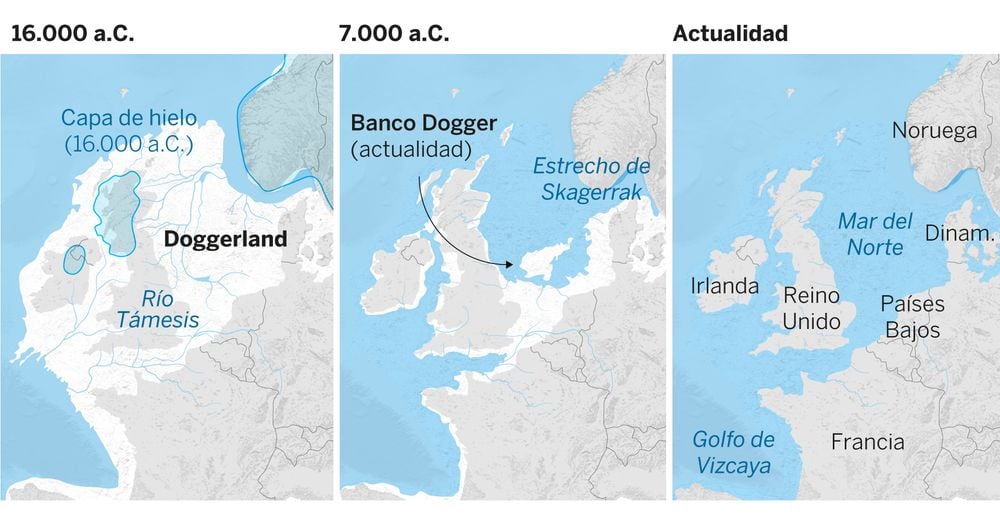For millennia, until the end of prehistory, Britain was not an island.
A huge strip of land linked the British shores with the rest of Europe, a sunken territory now known as Doggerland where herds of mammoths and reindeer lived, where lions and cave bears roamed, where humans settled. villages, hunted and fished.
But they were expelled as a consequence of the enormous episode of climate change that represented the end of the last ice age.
Experts estimate that for almost six millennia (11,000-5,000) this European Atlantis was slowly consumed by the waters until, finally, turned into an island, it was swallowed by the North Sea when agriculture reached Europe and began to be built the first pyramids in Egypt (before yesterday in historical terms).
And now, Doggerland is back with force in the form of literature: different books have been published about that lost land that reminds us, from its silence under the sea, of human fragility in the face of the weather.
Doggerland
, by the French writer Élisabeth Filhol, who has just published Anagrama in translation by Rubén Martín Giráldez in Spain, tells the story of a professor of archeology at the University of St Andrews (Scotland) who travels to Denmark to give a lecture on that land flooded and that must cross the North Sea in the middle of the storm Xaver, which swept northern Europe in 2003. "This territory was inhabited, it was swallowed," writes Filhol.
“Different theses coexist, but all specialists agree on one point, when the Neolithic revolution reached the neighboring countries of the North Sea, Doggerland had already disappeared.
Excluded from European myths, from the collective imagination.
Can you see there, in that amnesia, the consequence of a peaceful truce, prolonged over several centuries, islanders against the continent?
We still do not feel threatened in Europe.
But at the rate that the Arctic is melting, we will soon
Elisabeth filhol
The oblivion is undoubted, because most Europeans do not know to what extent the geography of the continent was different during millennia, and they are not aware that territories in which human beings lived and died for centuries and centuries are now water.
Doggerland has returned with the unbridled climate crisis, because the water has started to rise again, but also because, as Filhol points out, Brexit has reinforced the idea of Britain as the island it was not for thousands of years.
"We know that the islands of the Pacific Ocean are disappearing," the French writer explains in an email interview.
“The living space of its inhabitants is reduced every year.
We still do not feel threatened in Europe.
But at the rate at which the Arctic is melting, we will soon.
Experts predict the demise of Venice, Amsterdam, even St. Petersburg by the end of this century.
It's a
remake
of what happened thousands of years ago, when Doggerland Island began to be permanently submerged.
Except at that time it was a natural phenomenon, because we were coming out of the Ice Age ”.
Mammoths and cave lions
In the middle of the 19th century, North Sea fishermen began to find objects that should not have been there: bones of mammoths or cave lions, human remains, arrowheads ... Normally they returned those incomprehensible remains to the waves, which they also appeared on the coasts and on the beaches.
In 1931, a ship drew a spearhead that could be dated to about 14,000 years, when that space was a vast frozen tundra still in the middle of the Ice Age.
That find finally aroused the interest of archaeologists, although it was not until the 1980s that all these findings began to be rationalized with researchers such as Jan Glimmerveen, who in his home in The Hague maintains the largest collection of Doggerland objects in the world, or Professor Bryony Coles, an English researcher who gave this territory its name after the North Sea sandbar called
Dogger
.
Bryony Coles is one of the characters featured in the recent original essay
Time Song.
Searching for Doggerland
(Jonathan Cape), in which the English writer Julia Blackburn, herself a collector of objects from that lost land, mixes poems, archaeological descriptions and stories of characters obsessed by that flooded area, people who have spent years scrutinizing beaches and estuaries in search of archaeological remains.
"I wanted to inhabit the past," says Blackburn by phone from England.
“I have always been interested in showing something that does not exist in literature, completing moments from the past.
I live on the coast and there are remains of Doggerland everywhere.
I've found mammoth bones myself.
I first heard about it at a conference, I didn't even know it existed before, even after I discovered bones.
I think we are still not totally aware of that part of a story, because there are no written testimonies of it.
Élisabeth Filhol explains: “We do not remember that the last European hunter-gatherers could go on foot from England to Denmark.
It is difficult to imagine a Europe with different contours.
In a human life, geography seems immutable.
But it is changing.
The younger generations will see landscapes transform ”.
Destroying tsunami at the end of the Ice Age
One of the protagonists of Filhol's novel, Marc, works for the oil industry, which has played an essential role in the gradual rediscovery of Doggerland because prospecting in the North Sea has made it possible to study the sea floor, to analyze the sediments at large depth to try to understand how the flood occurred.
The majority conclusion is that it was a gradual process: the land was changing little by little, with the increasing appearance of lagoons and marshes, which gradually became salinized.
However, scientists are also convinced that, at a certain point, the process was accelerated violently, mainly due to the so-called Storegga Tsunami, caused by a brutal landslide in Norway (100 kilometers of coastline collapsed) 6,000 years ago.
The end of the Ice Age swallowed up this land, excluded from the collective memory
Not only prospecting for hydrocarbons has deepened understanding of Doggerland, but also the huge windmill farms for producing wind power that are being installed in the area.
Another of the recent novels about flooded Europe takes place in one of those installations.
It is entitled
Doggerland
and its author is the British Ben Smith: in a futuristic setting it tells the life of two characters in one of those isolated installations.
The literary reconstruction of that sunken world is completed with the Swedish writer Maria Adolfsson, who imagines in a series of detective novels, starring the detective Karen Eiken Hornby, that the island of Doggerland has survived to this day with a strange mixture of the Scandinavian world and British.
She has just published the third installment of a series translated into German, French, English and Italian, but not yet into Spanish.
Little by little, hand in hand with literature and science, Doggerland is emerging from the mists.
It is difficult to imagine a Europe in which the Rhine and the Thames were almost the same river, in which the Scandinavian countries had only the northern coast and the Netherlands were very far from the sea.
But, on the other hand, it is becoming less and less difficult to imagine that geography, battered by the elements, can change completely.


/cloudfront-eu-central-1.images.arcpublishing.com/prisa/KH67YFWGJRAVBEBG7T4N65XIWU.jpg)






